mobile View, to the German Version tap the flag


- Republic of Colombia
- democratical presidial republic
- own name: República de Colombia
• Flags
• Historical Flags
• Meaning/Origin of the Flag
• Coat of Arms
• Meaning/Origin of the Coat of Arms
• Aircraft Roundel
• Map
• Numbers and Facts
• History
• Origin of the Country's Name
• San Andrés y Providencia
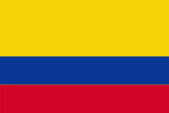
National flag,
ratio = 2:3,
Source, by: Corel Draw 4





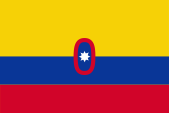
Merchant flag,
ratio = 2:3,
Source, by: Corel Draw 4



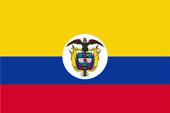
Naval flag,
ratio = 2:3,
Source, by: Flaggen und Wappen



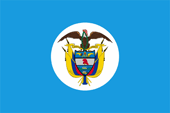
Naval jack,
ratio = 2:3,
Source, by: Wikipedia (DE)



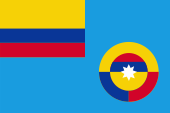
Flag of the Air Force,
ratio = 2:3,
Source, by: Flags of the World



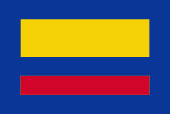
Customs flag,
ratio = 2:3,
Source, by:
Flags of the World, Flaggenbuch 1939



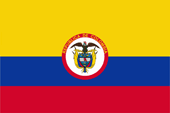
Flag of the president,
ratio = 2:3,
Source, by:
Flags of the World




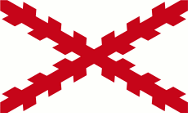
1538–1717,
Flag of the Kingdom of New Spain,
Source, by: Wikipedia (ES)




1717–1785,
Flag of the Vice-Kingdom of New Granada,
Source, by: Wikipedia (EN)



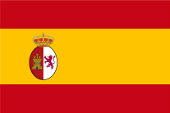
1785–1819,
Flag of the Vice-Kingdom of New Granada,
Source, by: Wikipedia (EN)




1806–1815,
Flag of the insurgent government



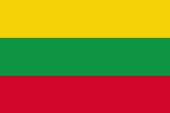
1814–1816,
National flag,
Source, by: Wikipedia (EN)



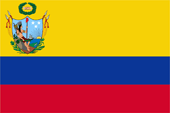
1819,
National flag of Great Colombia,
Source, by: Wikipedia (EN),
[CC BY-SA 4.0], via Wikimedia Commons



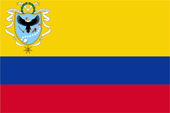
1820,
National flag of Great Colombia,
Source, by: Wikipedia (EN),
Milenioscuro [CC BY-SA 3.0], via Wikimedia Commons



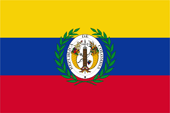
1821–1831,
National flag of Great Colombia,
Source, by: Wikipedia (EN),
Milenioscuro [CC BY-SA 3.0], via Wikimedia Commons



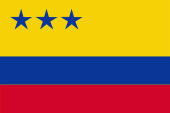
1822–1830,
Common flag of Great Colombia,
Source, by: Die Welt der Flaggen



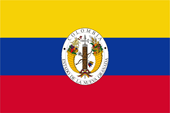
1831–1834,
National flag,
ratio = 2:3,
Source, by: Wikipedia (EN),
Milenioscuro, CC BY-SA 3.0, via Wikimedia Commons



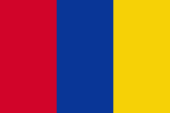
1834–1861,
National flag,
ratio = 2:3,
Source, by: Wikipedia (EN)



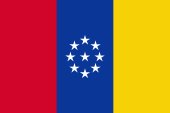
1861,
National flag,
ratio = 2:3,
Source, by: Wikipedia (EN)




The flag of Colombia – in the colours yellow, blue and red and exactly in the today's design – was in 1806 introduced by Francisco de Miranda (1750–1816). The wide yellow stripe should serve at some point in time to pick up a coat of arms or a room-sizing allegory. Since the beginning von the 19th century the flag was used in various some changed designs. For the first time it was in use already in the year 1807 during a campaign of the liberation army against places in the north of Venezuela. The colours yellow, blue and red should symbolize the separation of the country (colour of the country: yellow) from the colonial might of Spain (colour of the country: red) by the ocean (blue). Yellow stands as well for the wealth of the country, for the sunshine and the grain fields. Blue stands for the heaven, the ocean and the rivers, and red symbolizes the for the independence given blood. Ecuador and Venezuela use similar flags, a hint at the once historical unification of the countries Ecuador, Venezuela and Colombia within Great Colombia. The colours of the flag go back to Johann Wolfgang von Goethe, who had developed his own theory of colors and drew Miranda's attention in Weimar in 1785 with his ideas about colors and their psychological principles of action, and described yellow, blue and red as the colors mainly perceived by humans. Miranda chose yellow, blue and red as colours. It is often assumed that Miranda would have chosen "light blue", which can also be found on some flag representations from this region and time. This is problematic. Flags as historical finds are often viewed with the modern eye, and a specific color designation is quickly used. That ignores completely the fact that the light blue is due to washout and bleaching, a property known to Indigo (no other dye was known at that time) until today and also suitably exploited. 1815 thay decided to continue the struggle against Spain under flags in the colours yellow, green and red. In 1819, the United Provinces of Neugranada (the later Colombia) merged with the provinces of Quito (Ecuador) and Venezuela under the leadership of Simón Bolívar to form the Republic of Great Colombia. On this occasion, the colors yellow, blue and red were revived and taken over for the flag of the country, again with the wide yellow stripe, which now showed an allegory in the upper corner with a sitting Indian. After only one year the coat of arms was changed, the blue shield showed now a Condor and several stars. After one year, in 1821, the coat of arms was changed again. It was now a kind of a cartridge, showing a bundle of lictors and two filler horns and all around the name of the country. It was now placed in the middle of the flag, which now had three equally wide stripes. This flag was retained until the end of Great Colombia in 1830. The country disintegrated into the states of Neugranada, Venezuela and Ecuador after the death of Simón Bolívar. The flag of Great Colombia, however, was commonly used in practice without a coat of arms, the upper corner was supplemented by three blue stars. These stood for the three provinces of Neugranada, Venezuela and Quito. Apparently, this flag was easier to make. The after the separation of Ecuador and Venezuela remaining Colombia now called themselves New Granada, but retained initially the flag of Great Colombia, only the name of the country was changed in the transcription of the coat of arms. This flag was only in use until 1834. Thereafter the colours yellow, blue and red were arranged verticaly, without coat of arms. In occasion of the proclamation of the United States of Colombia in the year 1861 the blue middle-stripe was supplemented for four month by eight white stars which were arranged circularily around a ninth star in the middle. Then was adoped again the flag of 1806 and maintained until today. In its today's design the flag was precisely defined on 26th of November in 1861 by a decision of the president. It shows three horizontal stripes in yellow, blue and red in proportion 2:1:1. The widen yellow stripe should give space again for coats of arms or allegorical depictions, but this was not used until today. If coats of arms or similar things occur, they are placed in the middle of the flag. The colours of the flag today are defined as yellow = Pantone 116, blue = Pantone 287 and red = Pantone 186. The light blue that appears on some flags is assumed to be Pantone 2925. Of course, this does not apply to historical flags, as such standards did not exist at that time. Nevertheless, the modern standards were used for the representation of the historical flags on this website.
Source:
Die Welt der Flaggen, Volker Preuß, Wikipedia (EN)

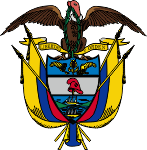
Coat of arms of Colombia,
Source: Corel Draw 4

The coat of arms of the state is in its fundamental structures from the year 1832, but was again and again – finally in the year 1955 – few changed. It shows on a by flags surrounded shield two cornucopias, a pomegranate and a Phrygian cap, underneath the Isthmus of Panama, which belonged until 1903 to Colombia. The pomegranate remembers the former name of the country "Neugranada". Above the shield a condor, the national bird of the country, and a golden banner with the motto of the state: "Libertad y Orden" → "Freedom and Order"
Source:
Flaggen Wappen Hymnen

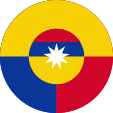
1927–1953,
Aircraft Roundel,
Source, by: Wikipedia (EN)
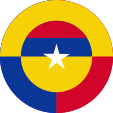
since 1953,
Aircraft Roundel,
Source, by: Wikipedia (EN)

Location:
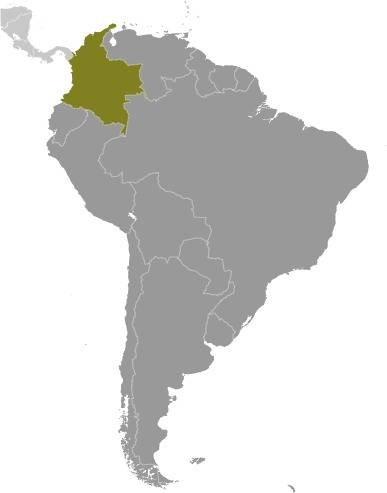
Source: CIA World Factbook
Map of the country:
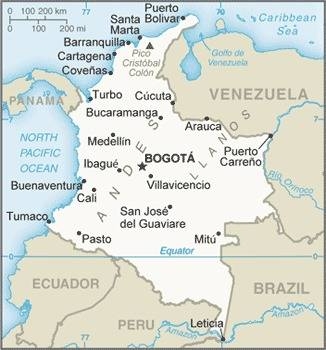
Source: CIA World Factbook

Area: 440.829 square miles
Inhabitants: 50.900.000 (2020), thereof 47% Mestizos, 40% Europeans, 7% Afro-Americans and Mulattos, 4% native Indians
Religions: 70% Roman Catholic, 20% Evangelicals
Density of Population: 115 inh./sq.mi.
Capital: Bogotá (former: Santa Fé de Bogotá), 7.901.653 inh. (2022)
official Language: Spanish
other Languages: Creole English, Indio languages
Currency: 1 Colombian Peso (COP, col$) = 100 Centavos
Time Zone: GMT – 5 h
Source: Wikipedia (D)

ca. 200 B.C.–ca. 500 A.D. · Calima Civilization in the central highlands
ca. 1000 A.D.–ca. 1600 · Tairona Civilization in the north of the country
1499 · the Spaniard Alonso de Ojeda discoverd the coast of Colombia
1505 · beginning of the Spanish exploration
1525 · beginning of the Spanish colonization
1527–1546 · the north of the today's Venezuela is in ownership of the German family of Welser
1536–1539 · Spain conquers whole Colombia and destroys in 1538 the Empire of the Chibcha in the highlands
1739 · formation of the Vice-Kingdom of New Granada, which includes the today's countries Colombia, Venezuela, Ecuador and Panama
1781 · great anti-Spanish revolt
20th of July 1810 · proclamation of the independence from Spain
1810–1819 · independence war against Spain under leadership of Simón Bolívar
1819 · proclamation of the Republic of Great Colombia (former Vice-Kingdom of New Granada)
1830 · Venezuela and Ecuador separate themselves by civil wars from Great Colombia, Great Colombia gets renamed in Republic of New Granada
1856 · military intervention of the USA
1858 · the Republic of New Granada gets renamed in Granadian Confederation
1860 · military intervention of the USA
1861 · proclamation of the United States of Colombia
1885 · military intervention of the USA
1886 · proclamation of the Republic of Colombia
1891–1896 · frontier-quarrels with Venezuela
1895 · military intervention of the USA
1899–1903 · civil war
1901–1902 · military intervention of the USA
1903 · the Province of Panama separates itself at the instigation of the USA from Colombia and declares its independence
1921 · Colombia recognizes the independence of Panama
1931–1942 · frontier-quarrels with Peru
1948–1953 · civil war („violencia“)
1953–1957 · military dictatorship under G. Rojas Pinilla
1965–2004 · civil war between rival militias, the communist groups FARC and ELN, drug cartels and the government
1991 · new constitution
2016/2017 · attempts at peace agreements between the government and FARC and ELN
Source:
Atlas zur Geschichte,
Wikipedia (D),
Discovery '97,
Weltgeschichte

The name of the country is a reminiscence of Christopher Columbus, who discovered America in 1492.
Source: Handbuch der geographischen Namen


![]()

























































